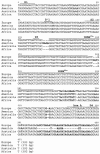Genetic diversity of Cylindrospermopsis strains (cyanobacteria) isolated from four continents
- PMID: 15691973
- PMCID: PMC546679
- DOI: 10.1128/AEM.71.2.1097-1100.2005
Genetic diversity of Cylindrospermopsis strains (cyanobacteria) isolated from four continents
Abstract
The genetic diversity of Cylindrospermopsis strains (cyanobacteria) was examined using mainly the 16S-23S internally transcribed spacer (ITS1) sequences. Strains were grouped in three clusters: (i) America, (ii) Europe, and (iii) Africa and Australia. These results suggested a recent spread of Cylindrospermopsis across the American and European continents from restricted warm refuge areas instead of exchanges between continents. On the other hand, they also suggested a recent colonization of Australia by African strains.
Figures


References
-
- Baurain, D., L. Renquin, S. Grubisic, P. Scheldeman, A. Belay, and A. Wilmotte. 2002. Remarkable conservation of internally transcribed spacer sequences of Arthrospira (“Spirulina”) (Cyanophyceae, Cyanobacteria) strains from four continents and of recent and 30-year-old dried samples from Africa. J. Phycol. 38:384-393.
-
- Boyer, S. L., J. R. Johansen, and V. R. Flechtner. 2002. Phylogeny and genetic variance in terrestrial Microcoleus (cyanophyceae) species based on sequence analysis of the 16S rRNA gene and associated 16S-23S ITS region. J. Phycol. 38:1222-1225.
-
- Briand, J.-F., C. Leboulanger, J. F. Humbert, C. Bernard, and P. Dufour. 2004. Cylindrospermopsis raciborskii invasion at mid-latitudes: selection, wide physiological tolerance or global warming? J. Phycol. 40:231-238.
-
- Briand, J. F., C. Robillot, C. Quiblier-Llobéras, J. F. Humbert, A. Couté, and C. Bernard. 2002. Environmental context of Cylindrospermopsis raciborskii (cyanobacteria) blooms in a shallow pond in France. Water Res. 36:3183-3192. - PubMed
-
- Chapman, A. D., and C. L. Schelske. 1997. Recent appearance of Cylindrospermopsis (cyanobacteria) in five hypertrophic Florida lakes. J. Phycol. 33:191-195.
Publication types
MeSH terms
Substances
Associated data
- Actions
- Actions
- Actions
- Actions
- Actions
- Actions
- Actions
- Actions
- Actions
- Actions
- Actions
- Actions
- Actions
- Actions
- Actions
- Actions
- Actions
- Actions
- Actions
- Actions
- Actions
- Actions
- Actions
- Actions
- Actions
- Actions
- Actions
- Actions
- Actions
- Actions
- Actions
- Actions
- Actions
- Actions
- Actions
- Actions
- Actions
- Actions
- Actions
- Actions
- Actions
- Actions
- Actions
- Actions
- Actions
- Actions
- Actions
- Actions
- Actions
- Actions
- Actions
LinkOut - more resources
Full Text Sources
Other Literature Sources
Molecular Biology Databases

